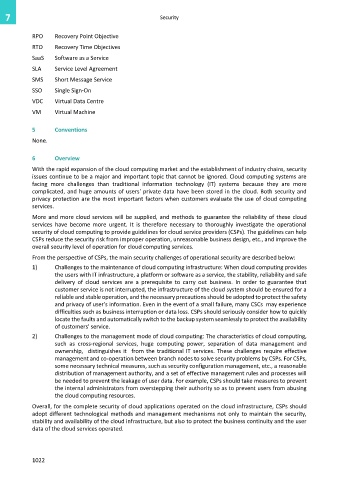Page 1030 - Cloud computing: From paradigm to operation
P. 1030
7 Security
RPO Recovery Point Objective
RTO Recovery Time Objectives
SaaS Software as a Service
SLA Service Level Agreement
SMS Short Message Service
SSO Single Sign-On
VDC Virtual Data Centre
VM Virtual Machine
5 Conventions
None.
6 Overview
With the rapid expansion of the cloud computing market and the establishment of industry chains, security
issues continue to be a major and important topic that cannot be ignored. Cloud computing systems are
facing more challenges than traditional information technology (IT) systems because they are more
complicated, and huge amounts of users' private data have been stored in the cloud. Both security and
privacy protection are the most important factors when customers evaluate the use of cloud computing
services.
More and more cloud services will be supplied, and methods to guarantee the reliability of these cloud
services have become more urgent. It is therefore necessary to thoroughly investigate the operational
security of cloud computing to provide guidelines for cloud service providers (CSPs). The guidelines can help
CSPs reduce the security risk from improper operation, unreasonable business design, etc., and improve the
overall security level of operation for cloud computing services.
From the perspective of CSPs, the main security challenges of operational security are described below:
1) Challenges to the maintenance of cloud computing infrastructure: When cloud computing provides
the users with IT infrastructure, a platform or software as a service, the stability, reliability and safe
delivery of cloud services are a prerequisite to carry out business. In order to guarantee that
customer service is not interrupted, the infrastructure of the cloud system should be ensured for a
reliable and stable operation, and the necessary precautions should be adopted to protect the safety
and privacy of user's information. Even in the event of a small failure, many CSCs may experience
difficulties such as business interruption or data loss. CSPs should seriously consider how to quickly
locate the faults and automatically switch to the backup system seamlessly to protect the availability
of customers' service.
2) Challenges to the management mode of cloud computing: The characteristics of cloud computing,
such as cross-regional services, huge computing power, separation of data management and
ownership, distinguishes it from the traditional IT services. These challenges require effective
management and co-operation between branch nodes to solve security problems by CSPs. For CSPs,
some necessary technical measures, such as security configuration management, etc., a reasonable
distribution of management authority, and a set of effective management rules and processes will
be needed to prevent the leakage of user data. For example, CSPs should take measures to prevent
the internal administrators from overstepping their authority so as to prevent users from abusing
the cloud computing resources.
Overall, for the complete security of cloud applications operated on the cloud infrastructure, CSPs should
adopt different technological methods and management mechanisms not only to maintain the security,
stability and availability of the cloud infrastructure, but also to protect the business continuity and the user
data of the cloud services operated.
1022

